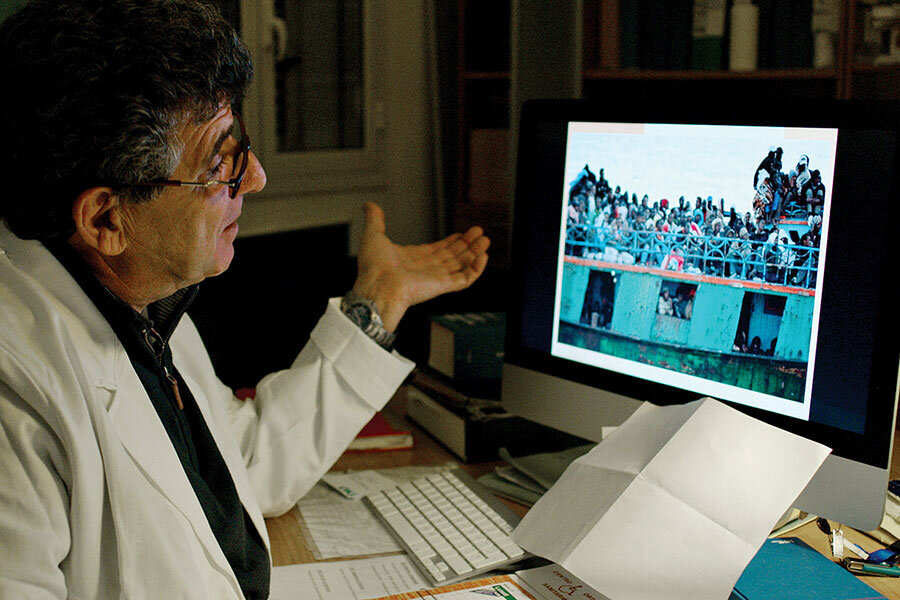'Fire at Sea' provokes questions about director’s choices
Loading...
The Italian documentary “Fire at Sea,” directed by Gianfranco Rosi, opens on a note of terror: A radio dispatcher on the Mediterranean island of Lampedusa gets a distress call from a sinking ship of African refugees. “What is your position?” he asks. “God help us,” a woman answers. “We beg you.”
About eight square miles in size, located between Libya and Sicily, Lampedusa has for the past 20 years been the destination for more than 400,000 fleeing refugees, mostly Africans as well as some Syrians, as they attempt to cross into Europe. Of this number, an estimated 15,000 have died.
Rosi spent a year living on Lampedusa making this documentary, which is not, especially given the way it opens, what one might expect from this material. (It won the Golden Bear at the Berlin Film Festival.) Instead of a hard-hitting insider’s exposé about the tragic plight of refugees, it’s closer to a tone poem about the daily life of the Lampedusan islanders, who, except for a few that we are shown, barely register the maelstrom around them. This approach is occasionally allusive and lyrical but also, in any political sense, insubstantial.
Because the island’s immigration center can’t hold all the refugees, the ones that survive the ocean voyage in overladen, unsanitary boats are processed to Sicilian detention centers almost immediately upon landing. From there they are assigned to various regions in Italy. (This last stage is not shown or even much commented upon.)
The refugees are a world apart from the islanders. Except for the island’s sole physician and the rescue crews, the residents have no apparent interaction with the refugees. I was grateful that Rosi kept at least some of the film’s focus on that physician, Pietro Bartolo, whose job, as it has been for decades, is to determine the health and survivability of each human cargo. In the film’s most bracing moment, Bartolo describes the toll that his ministrations have taken on him. This decent, immensely caring man could easily have served as the film’s centerpiece.
But Rosi spends undue time with the preteen Samuele Pucillo, who is shown fashioning a slingshot, being bored in the classroom, getting seasick, and, in an extended family dinner sequence, slurping spaghetti. Is Rosi’s point that Samuele is insensitive to the horrors washing ashore? That’s a heavy accusation to lay on the kid. The suggestion that Samuele may be repressing his discomforts comes only in a brief scene with Bartolo, in which the boy’s complaints about shortness of breath are determined to be likely anxiety-related. It’s too slim a diagnosis to mean much of anything in this film.
There’s something borderline dishonest about the way Rosi intercuts the oblivious, life-goes-on Lampedusans with the harrowing, too-brief footage of Africans inside the immigration center and aboard the rescue ships. His stylistics keep these two groups cruelly apart, but who knows if this is the way things actually play out?
Because Rosi doesn’t provide any narration or conduct on-camera interviews, we never hear the islanders discuss at any length how they really feel about the situation. (A woman, hearing a radio bulletin about a distressed ship, mutters for a few seconds about the poor souls aboard.) He shows us several times a radio DJ playing old Sicilian pop tunes for his listeners, and, again, I wondered: Is Rosi castigating these people for whistling while Lampedusa burns? From what he shows us, the innocence of these islanders is a fool’s paradise. But can we trust what he shows us?
One thing we can trust, and it’s what makes the movie worth seeing, is the sequence with the Africans chanting in the detention center about making it from Africa, through the scorching Sudanese desert and Libya, to Lampedusa. Their ecstasy in being saved is both supremely joyous and sorrowful (because so much has been lost in the journey). When Rosi closes the film with a shot of the lower hold of a refugee ship, with corpses strewn like discarded laundry, there is no way to respond except with abject silence. Grade: B- (This movie is not rated.)







